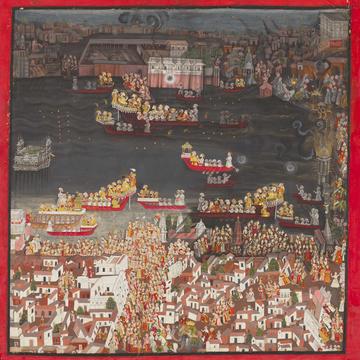Conveners: Imre Bangha, Polly O'Hanlon, and Kate Sullivan de Estrada
Speaker: Dipti Khera (NYU)

Maharana Sangram Singh II at the Gangaur Boat Procession, c. 1715–20, Udaipur. Gouache and gold on paper, 78.7 x 78.74 cm. The City Palace Museum, Udaipur; 2012.19.0014_R. Photography courtesy of the Freer Gallery of Art and Arthur M. Sackler Gallery, Smithsonian Institution. Photographer: Neil Greentree. © Maharana of Mewar Charitable Foundation, The City Palace Museum, Udaipur.
Abstract:
As Mughal imperial authority weakened by the late 1600s and the British colonial economy became paramount by the 1830s, new patrons and mobile professionals reshaped urban cultures and artistic genres across early modern India. In iterating exuberant and ephemeral atmospheres of their city of lakes, painters from Udaipur viewed the moods of places as open to adaptation, admiration, and assimilation. Drawing upon the recently published book The Place of Many Moods: Udaipur’s Painted Lands and India’s Eighteenth Century, this talk will discuss pictures of pleasure, plentitude, and praise that sought to stir such emotions as love, awe, abundance, and wonder. Their memorialized moods confront the ways colonial histories have recounted Oriental decadence, emphasizing the senses, spaces, and sociability essential to the efficacy of objects and expressions of territoriality.
Bio:
Dipti Khera is Associate Professor in Art History and Institute of Fine Arts at NYU. As a scholar of early modern South Asia, with interdisciplinary training in art history, museum anthropology, and architecture, her research and teaching integrate longue durée perspectives and Indian Ocean and Eurasian geographies, and foreground art history's (re)making of colonized and racialized pasts. Khera's The Place of Many Moods: Udaipur's Painted Lands and India's Eighteenth Century (Princeton, 2020, awarded American Institute of Indian Studies' Edward Cameron Dimock, Jr. Prize) reveals powerfully immersive and politically contingent conceptions of a place's moods. It raises broader questions about how ecologies, emotions, aesthetics, and artifacts operate to constitute histories and collectives. Her articles have addressed the crafting of colonial taste and design by Indian silversmiths; material histories of eighteenth-century pleasures; entangled mobilities and conceptual affinities between disparate maps and scrolls that enabled long journeys. Her collaborative work with Rajasthan's museums has led to conservation, exhibition, and digital projects, including co-curating with Debra Diamond, A Splendid Land: Paintings from Royal Udaipur (opening in November 2022 at the Smithsonian's National Museum of Asian Art). With Sarah Betzer, she is co-editing a forthcoming volume for Journal18 (Fall 2022), “The 'Long' Eighteenth-Century?," which explores from which vantage points, whether local, regional, or transregional, and for whom, is the eighteenth century long.
Please register via Eventbrite https://www.eventbrite.co.uk/e/modern-south-asian-studies-seminar-series-trinity-term-tickets-150876416423